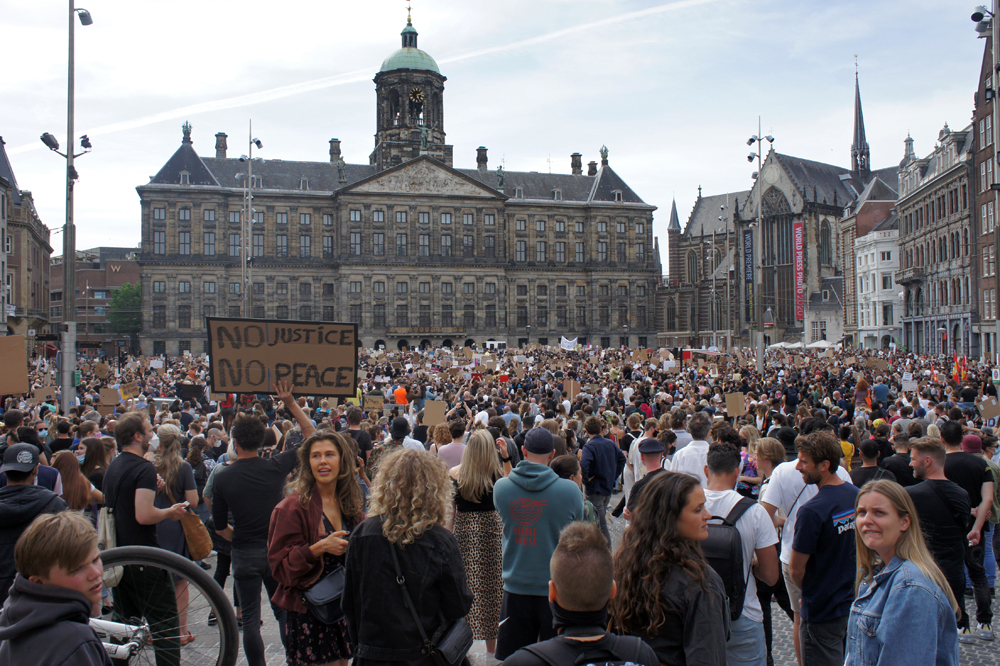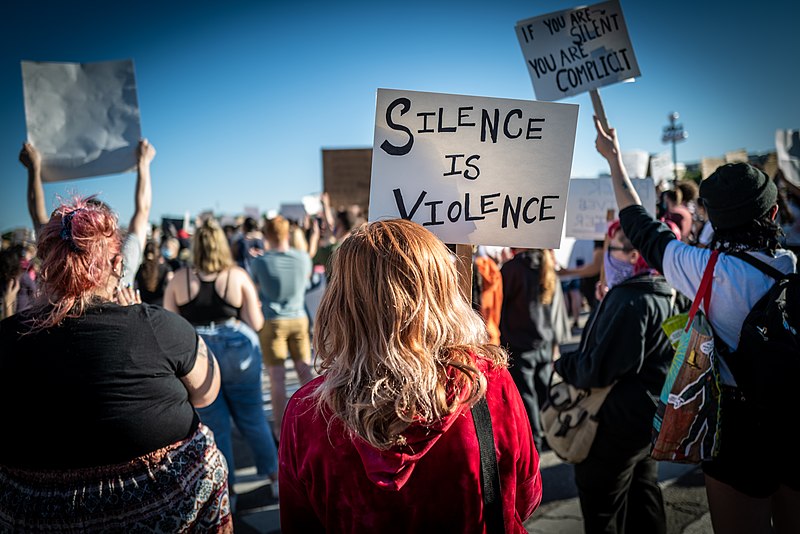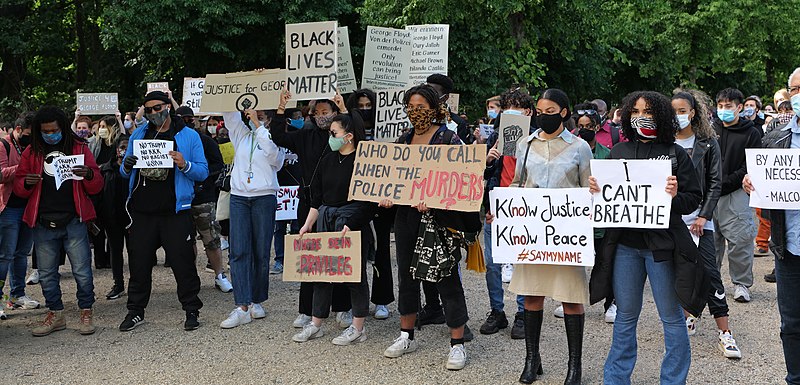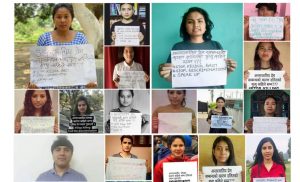The protests in the US are about police brutality, but also lots more.

“What in the world is going on in the US?” Nepali friends have been asking me a lot lately. They asked this a couple of months ago as the number of Covid-19 cases in the US exploded. Now, they are asking again in the wake of the George Floyd killing and protests. They ask because they know I am an American historian. They also ask because they know that my mawalighar is Minnesota, near where Floyd was killed.
Questions about American history from Nepalis are not new to me. When I worked in Khotang as a teacher in the early 1990s, I would ask friends about Nepali history and they would ask me about American history. I loved these discussions, but it was often hard to explain things — Nepal was such a long way from the US, and industrial western society differed greatly from Nepal’s agricultural society.
Interestingly, some of the people who recently asked about US events actually have family members working or studying there. This was not the case in Khotang back in the 90s. Indeed, several friends from Khotang’s remote corners now live in the US. With many Nepalis working or studying in America these days, the two countries are much more connected at an individual level.
Those connections make it more important than ever that Nepalis understand American history. As a historian, I feel this intensely.
George Floyd was a black American man who, having lost his job because of Covid-19, allegedly used a fake $20 dollar note in a shop in Minneapolis, Minnesota, an industrial and agricultural centre in the north-central part of the US. He died as a white police officer held him down with his knee on Floyd’s neck for over eight minutes, even though Floyd was on the ground and his hands were handcuffed behind his back. Because of the similarity to other episodes of excessive force by police against black men, protests erupted in Minneapolis and in communities around the US. Black Americans have led these protests, but Americans of all races have supported them.
 My quick answer to the “What’s going on in America?” question is this: It is complicated. There is a long history of discrimination in the US between whites and blacks, somewhat similar to caste discrimination in Nepal, going back to the 250 years of slavery in the US. This injustice is still shaping American society.
My quick answer to the “What’s going on in America?” question is this: It is complicated. There is a long history of discrimination in the US between whites and blacks, somewhat similar to caste discrimination in Nepal, going back to the 250 years of slavery in the US. This injustice is still shaping American society.
Nepalis may think of the US as a land of opportunity; it is for many. But, that opportunity has often depended upon the colour of your skin and the neighbourhood you were born into. The protests are about white police using unnecessary force against black people, often but not always in poor neighbourhoods, but also about the long history of discrimination and unfairness.
That is a short answer. For a longer answer, I ask them to bring some tea, and we look for a place to talk while maintaining physical distancing to prevent coronavirus infection.
As a historian, I like to place current events within the long arc of the American past. I focus my explanation around four American stories that I think also have special meaning for Nepalis: slavery, civil war, World War II, and rural to urban migration. All involve deep injustice to African Americans, but also show their profound perseverance.
Tobacco, cotton, and rice slavery
Most black Americans (also called African Americans) in the US today are the descendants of people first brought to North America as slaves in the 17th and 18th centuries, often to make tobacco, cotton, and — surprisingly — rice.
America’s slave system lasted for almost 250 years (1620-1865); that is longer than since slavery. And for most of the 150 years since slave emancipation, economic exploitation and political oppression have persisted. So, in the 400-year history of black people in North America, only in the last generation, since freedom movements of the 1960s, have conditions significantly improved.
It all started with those two and a half centuries of slavery in the US South. Many people know tobacco plantations with slaves made Virginia and Maryland rich, and that slaves picking cotton made plantation owners from Georgia to Texas rich. There was rice, too — rice plantations worked by slaves helped white landowners in South Carolina and Georgia grow rich.
European guns and disease killed and displaced most indigenous peoples (“Red Indians”) from the east coast of North America, making land plentiful. Labour, though, was scarce. So, using guns and whips, Europeans brought Africans stolen from their families and villages to grow tobacco and rice.
In total, 600,000 slaves were brought to lands that would become part of the USA. (Almost 12 million went to Haiti, Cuba, and Brazil.) The ships that brought the slaves were nightmares — dirty, crowded, and deadly. One in 10 died en route.
By 1860, four million slaves lived and worked in the US, most on tobacco, rice, and cotton plantations in the South — the area from Washington, DC to Texas.
The coastal areas of South Carolina and Georgia had swampy soil, not good for other crops, but excellent for rice. White British landowners did not know how to manage water or grow rice, but slaves from West Africa did. This region’s prosperity grew not just from the sweat of African slaves, but also their ingenuity.
Slaves were property without rights. They could be bought and sold, just like a sack of rice. Black children were sometimes torn from parents and sold far away. White owners often raped female slaves.
White masters controlled slaves with violence and terror –whipping, maiming, chaining, and even castration.
 Despite all this, slaves created families and rich traditions, including brilliantly creative music that gave them meaning and held them together despite the horrific hardships.
Despite all this, slaves created families and rich traditions, including brilliantly creative music that gave them meaning and held them together despite the horrific hardships.
The US-South was a race-based colony, similar to British India and apartheid South Africa. Economic exploitation and political oppression were justified by an assumed racial superiority.
The profits from slavery fuelled American capitalism. Tobacco and rice produced big profits, and cotton even more. New York merchants and the first American factories — cloth factories in Massachusetts — depended upon cotton made inexpensive by stealing the labour of blacks using violence.
Nepalis often ask me how the US became wealthy. I generally point to several factors: high literacy rates, good schools and universities, lots of land and resources, generally efficient government, but also the labour stolen from black slaves. American capitalism got a huge boost from the slave system.
This is not a long-gone history. The wealth from slavery still gets handed down generation to generation even today. Many families, organisations, and companies that made money from slavery still operate in the US.
What about American democracy? Prosperity from slavery helped make American ideas of political liberty possible. The writers of the American Declaration of Independence and the US Constitution were mostly wealthy white slave-owners. Thomas Jefferson owned slaves and had children with one slave, Sally Hemings. George Washington owned slaves. Eight of America’s first 12 presidents brought slaves with them to the White House.
The Constitution gave rights only to white men. Each slave was counted as three-fifths of a person to determine how many representatives a state would have in Congress, but they were denied all rights. They were treated as property, not people.
Despite these injustices, the US Constitution created and celebrated ideals of equality and democracy that later generations of blacks would fight for.
Today, it is African American protestors who have powerfully reminded the nation of core American values: what freedom means, what freedom of speech means, and what speaking truth to power means.
 The US civil war and afterwards
The US civil war and afterwards
In addition to the 250 years of tobacco, cotton, and rice slavery, the American civil war in the 1860s and its tragic aftermath profoundly shaped American society.
Nepalis know all too well about civil wars – their terrible disruption, violence, and pain. Nepalis fought a civil war in which many of their brothers and sisters died and then wrote a new constitution. Most importantly, they know that it is the period after civil wars — the negotiation over what changes will be implemented or not — that often have the most lasting impact.
In the US civil war, which raged between the northern states and southern states from 1861 to 1865, over 600,000 Americans died. At the war’s end, slavery was abolished and “equality before the law” was enshrined as the Constitution’s 14th amendment. The US appeared to take an important step towards becoming a real democracy.
But ending slavery did not mean political, economic, or social equality, or anything close. After the war, hopes soared and some changes resulted (black families could not be separated from each so easily), but within a couple of decades, the situation looked very similar to before the war.
Many former slaves were forced to return to work for their former owners as tenant farmers — under exploitative conditions, not unlike what many Nepali kamaiya and haruwa faced (and still face) in parts of Nepal.
Legally, after the war, black men gained the right to vote, but it was usually denied using bureaucratic measures and trickery. (Women only got the legal right to vote in 1920, and that was mostly white women.)
After the war, former slaves and their children pushed hard for democratic rights, better conditions, and basic dignity, but they encountered a wave of horrific violence to keep them down. The “Ku Klux Klan (KKK)” — an armed and violent organisation of white supremacists — enforced black subjugation. During this tense period, a black person was hanged or burned alive every four days.
In the end, historians tell us America’s white supremacists had lost the war but won the peace. Exploitation and discrimination continued to shape daily life for African Americans for almost another century.
America’s main challenge, the former slave Frederick Douglas noted, was “whether the American people have loyalty enough, honour enough, patriotism enough, to live up to their own Constitution.”
That would be the challenge of the twentieth century, especially as African Americans served in two world wars and increasingly moved from southern farms to cities like New York and Minneapolis. The world wars, and rural to urban migration, which I will write about in my next article, are also historical dynamics that many Nepalis are very familiar with.
Dr Robertson was a Peace Corps volunteer in Khotang from 1993 to 1996 and was director of Fulbright Nepal from 2017 to 2019. He is also a historian.
—
Photos from Wikimedia Commons





















